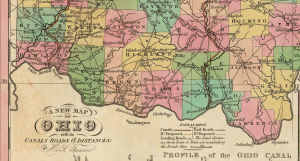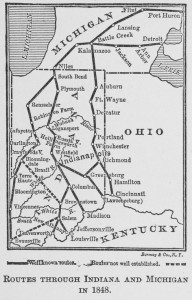The Road to Freedom through Cincinnati 1820–1860
In the early years of the 19th century, Denmark Vesey and Nat Turner and many other enslaved people led open rebellions against the institution of slavery. However, most resistance to slavery took the form of trying to run away. At first it was the younger, stronger men who succeeding by keeping ahead of the slave catchers and their dogs to emancipate themselves. These were unassisted escapes; daring freedom seekers setting off north orienting themselves by walking near a transportation route or following tributaries leading to the Ohio River.
The law was not on the side of those escaping, nor on the side of those helping them. In Ohio and other states created from the 1787 Northwest Territory, owning slaves was prohibited but it was still against the law to aid those escaping their bondage. Despite these laws, many abolitionists felt called to do more than talk about ending slavery.
As word got back about the best routes north and as free black communities north of the Ohio River were large enough to hide these runaways, a larger, interracial network of assistance was formed. Cincinnati’s black population was centered in ‘Bucktown,’ an area on the eastern edge of the city, below the hillsides of Cincinnati’s basin and near the slaughterhouses. Those fleeing north were drawn to this area because they felt safer here. Black churches were their first help. The Allen A. M. E. Temple dates back to 1808 and was burned down three times by proslavery gangs. The Zion Baptist and the Union Baptist Churches regularly hid slaves in their basements. If the slave catchers were moving in quickly, white abolitionists would aid them by transporting them out of the city or giving them disguises or cover by accompanying them so that they might use public transportation and be “hidden in plain sight.” While free black families were often the first point of contact to those escaping enslavement, their stories were not collected by the historians in the late nineteenth century and are now emerging through new research and scholarship.
An interracial network in Cincinnati, known as the Underground Railroad, continued to grow and be more capable of successfully and quickly assisting larger groups in their flight. Lane Seminary in Walnut Hills had been a transportation hub for many seeking freedom in the 30’s and early 40’s. Harriet Beecher Stowe gathered the background for her novel, Uncle Tom’s Cabin, from her home near Lane Seminary. Conductors drove freedom seekers from Walnut Hills to one of the many next houses north of the city. John Van Zandt, who lived in Glendale, was caught in 1842 assisting nine slaves escaping from Boone County Kentucky on their journey north. Although well defended before the Supreme Court by Salmon P., Chase, Van Zandt was found guilty in 1847, died a pauper the same year and was buried in Wesleyan Cemetery. The route from Walnut Hills was becoming too well known to remain safe.
Mt. Pleasant (now called Mt. Healthy) was the earliest village established along the Hamilton Road (its first name; after the mid-1830s it became the Cincinnati and Hamilton Turnpike, or Hamilton Pike). By 1810 there were two taverns in Mt. Pleasant, along with shops for necessities, at the midpoint of this well-traveled route between Cincinnati and the Butler County town of Hamilton, Ohio. By the late-1830s Charles Cheney, as president of the Cincinnati and Hamilton Turnpike, was appointing tollgate keepers who were friendly to Underground Railroad transport. The Cheneys, and other Mt. Pleasant residents such as the Lane and Hastings families were receiving frequent nighttime visits in the 1830s and 1840s. With a growing free black community, (artist Robert Duncanson who moved there in 1841 being its most famous early resident), there were opportunities for fugitives to blend into the community during the day and receive respite on their way north. Oral tradition from one local descendant of a former slave recounts that fugitive slaves were given safe overnight haven in the homes of the white abolitionists, and in the morning the fugitives would be fed and provisioned for their journeys in the home of her ancestor, to be ferried north in the carriages and wagons of participating white farmers.
The route north through Glendale disappeared with the arrest and trial of VanZandt. Once Levi Coffin moved to Cincinnati in 1847, he joined the Vigilance Committee formed to protect free blacks in the city. This brought him into contact with many in the free black community and connected them to a new route through Cumminsville, College Hill, Mt. Healthy and northwest through his former Quaker community of Newport, Indiana (now Fountain City). This route to Canada was safer, used black and white conductors in Indiana and Michigan and could accommodate the larger groups that came to Cincinnati after the Fugitive Slave Act. The Quaker community in Oberlin, Ohio defined another route north, and led to the port of Sandusky.
When large groups escaped together, newspapers called them “slave stampedes.” On April 2nd, 1853, there was such an escape, named by Levi Coffin as “The Company of Twenty-Eight Fugitives” whose route was what is now Hamilton Avenue with an overnight stay in College Hill. This was the largest and best documented flight to freedom across the Ohio River at Cincinnati, but was just one of many escapes on this important Underground Railroad route in the 1850s.
Further Reading
1. Nikki Taylor, Frontiers of Freedom: Cincinnati’s Black Community, 1802- 1866 (Athens:Ohio University Press, 2005)
2. Levi Coffin, Reminiscences of Levi Coffin, (Cincinnati, OH: Robert Clarke & Co., 1880),309-310. https://docsouth.unc.edu/nc/coffin/coffin.html
3. Harriet N. Wilson, Letter to Wilbur H. Siebert, April 14, 1892, Wilbur H. Siebert Collection annotated by Betty Ann Smiddy and Diana Porter (Cincinnati, 2013) www.HamiltonAvenueRoadToFreedom.org/
4. Betty Ann Smiddy and Diana Porter, Escape of the Twenty-Eight , (Cincinnati, 2013)
5. William Siebert, The Underground Railroad from Slavery to Freedom, (New York, New York: Arno Press, 1898)
6. Elihu Burrit Beard:A Diary for 1849, edited by Thomas Beard, 1999 available as an eBook.
7. Penny A. Ralston, The Cabin Creek Settlement: Historical Study of a Black Community in Randolph County, Indiana, (Muncie, Indiana, 1971)
8. Frank Woodbridge Cheney, The Underground Railroad, unpublished manuscript, 1901, held by Connecticut Historical Society.
Betty Ann Smiddy and Diana Porter, Cincinnati, January 10, 2014
Karen Arnett, Cincinnati, February 7, 2014

